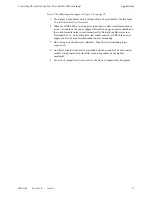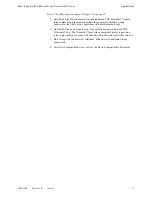
Programming Options
Programmable Features Description
22
FCPS-24FS PN 51883:B 12/04/02
3.2.4 Input/Output Function
DIP switches 5 and 6 are used to determine the Input Control circuits that will activate
the four output circuits and the function of the output circuits. For example, to
configure a
General Alarm
operation in which Input Control Circuit #1 activates all
four output NACs, DIP switches 5 and 6 are both set to the OFF position. In this
configuration, the Sync Input circuit is ignored if the power supply is set as a Master
but will be monitored if the supply is set as a Slave. In addition, if the Auxiliary Power
output is set as a resettable output, the circuit connected to Control Input Circuit #2 will
control the auxiliary power reset function.
The following table details the four possible input/output configurations:
3.2.4.1 Auxiliary Power Control
The 24 VDC Auxiliary power from TB4 Terminals 9(+) & 10(-) can be resettable or
nonresettable power only when the power supply is configured for General Alarm
operation. For all other configurations, the auxiliary power output is only
nonresettable.
In the General Alarm configuration, the Auxiliary power output can be made
resettable by applying a steady signal to Control Input 2 (positive 12 to 24 VDC on
TB4 Terminal 7 and common on Terminal 8). Temporarily removing the voltage or
reversing the polarity will cause the Auxiliary power output to reset for 6 seconds.
Table 3.3 Input/Output Configurations
DIP Switch 5
DIP Switch 6
Input/Output Function
OFF
OFF
General Alarm
• FCPS configured as Master (switch 3 OFF), NAC Outputs 1 through 4
1
are controlled by
Control Input #1; Sync Input is ignored.
• FCPS configured as Slave (switch 3 ON), NAC Outputs 1 through 4
2
are controlled by
Control Input #1; Sync Input is monitored
2
.
• Resettable or nonresettable Auxiliary Power Output is available from TB4 Terminals 9 &
10. Control Input #2 determines if reset will occur (must go from On to Off for a 6 second
reset to occur).
OFF
ON
Split Alarm
• FCPS configured as Master (switch 3 OFF), NAC Outputs 1 & 2 are controlled by
Control Input #1 and Outputs 3 & 4
1
are controlled by Control Input #2; Sync Input is
ignored.
• FCPS configured as Slave (switch 3 ON), NAC Outputs 1 & 2 are controlled by Control
Input #1 and Outputs 3 & 4
1
are controlled by Control Input #2; Sync Input is monitored
2
.
• Only nonresettable Auxiliary Power is available from TB4 Terminals 9 & 10
ON
OFF
Split Temporal
• FCPS configured as Master (switch 3 OFF), Control Input #1 controls NAC Outputs 1 &
2 and Control Input #2 controls Outputs 3 & 4
1
which will generate a Temporal code
signal without sync; Sync Input is ignored.
• FCPS configured as Slave (switch 3 ON), Control Input #1 controls NAC Outputs 1 & 2
and Control Input #2 controls Outputs 3 & 4
1
which will generate a Temporal code signal
without sync; Sync Input is monitored for Outputs 1 & 2
2
.
• Only nonresettable Auxiliary Power is available from TB4 Terminals 9 & 10
ON
ON
Selective Silence
3
• FCPS configured as Master (switch 3 OFF), NAC Outputs 1 through 4
1
are controlled by
Control Input #1; Sync Input is ignored.
• Control Input #2 determines when Selective Silence for all outputs will occur
• Only nonresettable Auxiliary Power is available from TB4 Terminals 9 & 10
1
If Door Closer function is selected (switch 8 ON), Output 4 does not function as an NAC, therefore sync input is ignored for
Output 4.
2
If
no synchronization
is selected by switches 1 & 2, the Sync Input is ignored.
3
Selective Silence allows the silencing of the sounder portion of a horn/strobe combination device without turning off the strobe.
Содержание FCPS-24FS6
Страница 4: ...4 FCPS 24FS PN 51883 B 12 04 02 Notes ...
Страница 6: ...6 FCPS 24FS PN 51883 B 12 04 02 Notes ...
















































